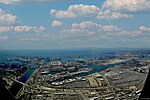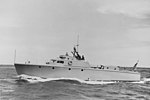Long Beach Naval Shipyard
1943 establishments in California1997 disestablishments in CaliforniaBuildings and structures in Long Beach, CaliforniaClosed installations of the United States NavyEconomy of Long Beach, California ... and 7 more
Manufacturing plants in the United StatesMilitary installations closed in 1997Military installations established in 1943Portal templates with redlinked portalsShipyards in CaliforniaTerminal IslandUnited States Navy shipyards

The Long Beach Naval Shipyard (Long Beach NSY or LBNSY), which closed in 1997, was located on Terminal Island between the city of Long Beach and the San Pedro district of Los Angeles, approximately 23 miles south of the Los Angeles International Airport. The primary role of NSY Long Beach at the time of its closure was overhaul and maintenance of conventionally-powered US Navy surface ships, but it also had served as the homeport for several auxiliary ships during its operating history.
Excerpt from the Wikipedia article Long Beach Naval Shipyard (License: CC BY-SA 3.0, Authors, Images).Long Beach Naval Shipyard
Seaside Freeway, Long Beach
Geographical coordinates (GPS) Address Nearby Places Show on map
Geographical coordinates (GPS)
| Latitude | Longitude |
|---|---|
| N 33.757222222222 ° | E -118.23111111111 ° |
Address
Seaside Freeway
90831 Long Beach
California, United States
Open on Google Maps










